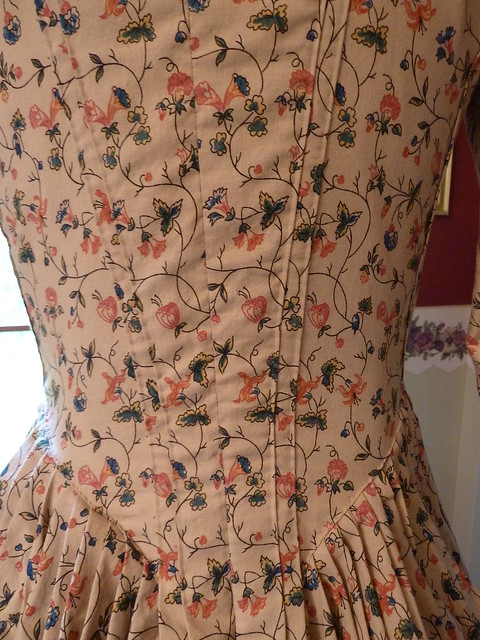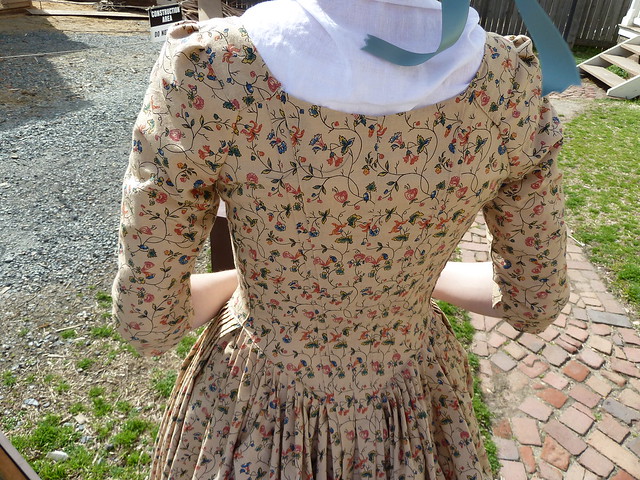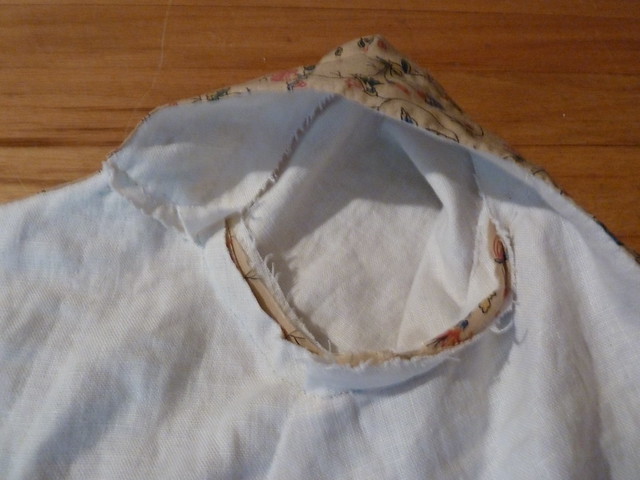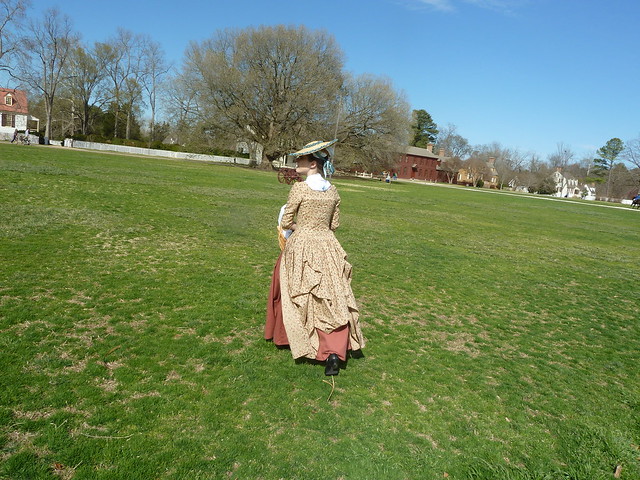A Cotton Print Gown, 1775-1780
Ashley at Colonial Williamsburg, March 2011
The pattern: The bodice of the gown was draped by me directly on Ashley. The curve of the back neckline was a feature I found on the gown on page 36 of Janet Arnold's Patterns of Fashion 1; since all of Ashley's other English gowns have the pleats cut straight across the back, I thought the curve would be a nice and unique way to change things up a bit. I borrowed the sleeve pattern from the same gown in Arnold, since I still haven't mastered the technique of draping these late-period tighter sleeves that need to curve over the elbow. The slightly longer sleeves that fully cup over the elbow and extend a bit further onto the lower arm help to date the gown to the very late 1770s and early 1780s.
 Construction Details: As always, the gown in completely hand-sewn. First, I draped and cut the shape of the back linen lining piece and pinned it to Ashley's stays; the en fourreau pleats were then arranged and pinned in place onto the linen, kept secured very close against Ashley's body so that the width at the shoulders and at the waist was kept in proportion to both her body shape and the style of the gown. The lining and pinned outer fabric were then unpinned from her stays and I secured the pleats down to the linen, working flat on a table to prevent puckering, with a spaced backstitch (as is consistent with most examples of en fourreau gowns).
Construction Details: As always, the gown in completely hand-sewn. First, I draped and cut the shape of the back linen lining piece and pinned it to Ashley's stays; the en fourreau pleats were then arranged and pinned in place onto the linen, kept secured very close against Ashley's body so that the width at the shoulders and at the waist was kept in proportion to both her body shape and the style of the gown. The lining and pinned outer fabric were then unpinned from her stays and I secured the pleats down to the linen, working flat on a table to prevent puckering, with a spaced backstitch (as is consistent with most examples of en fourreau gowns).The next step was to pin the back piece back onto Ashley's stays and make fish darts along the waistline to mark where the skirt fabric needed to be cut free from the bodice.
Detail of the back "en fourreau" pleats.
After trimming the back panel to match the lining shape on the sides, I draped the front bodice pieces in the linen lining fabric and then cut out the cotton fabric using those as my pattern. The front pieces were then lapped to the back and sewn down using spaced backstitches; their lining pieces were folded under and whipstitched into place inside to finish the seams and enclose all raw edges.
Interior of the bodice, showing the linen lining.
The tapes used to drape up the skirts are also visible.
The sleeves came next. Their undersides are first sewn onto the gown using a backstitch. I then had Ashley put the gown on so that the top halves of the sleeves could be pleated to fit directly to her shoulder. The interior seam of the armscye is left unfinished, in keeping with extant examples.
Interior view of the unfinished armscye and lapped front lining.
After laying the shoulder strap down over the sleeve cap, the front opening and the entire neckline of the bodice was finished by folding under the edges of the cotton and linen and stitching them together using "le point a rabattre sous la main."
Detail of the back neckline, "en fourreau" pleats, and the
shoulder strap and sleeve.
The final step was pleating the skirt to the bodice. This can be done either with the pleats all angled towards the center back, or with the pleats angled towards the side pocket slits. Both options are documented. For this gown, I didn't have time to sew pocket slits, so I simulated them using the pleating-to-the-sides option. Because of the full pleats in the skits, you can't tell at all that there aren't any real slits there! I left enough fabric in the two side pleats so that if I (or Ashley) want to add pocket slits at a later time, it can very easily be done. In the meantime, the pocket slits of her petticoat can be very easily accessed by pulling aside the gown's skirts, since they are set further to the side than the center, in keeping with this particular period.
The Fabric: This is a reproduction of an original early 1780s cotton print held in the collection of the DAR Museum. Most unfortunately, it is now out of print and extraordinarily difficult to find. I was lucky and caught an auction on ebay and bought everything the seller had left, which turned out to be exactly enough to make the gown, with literally no more than a handful of scraps left over. How period appropriate was that?!
The original "document" colorway of this print has a lighter coloring overall and is thus very typical of cotton prints from the late 1770s and early 1780s, with its cream-colored background and subtle greens, blues, and red/oranges.

The document colorway, reproduced exactly from the DAR original.
As quilting lines tend to do, the print was reproduced in its original colorway and with three additional color variations. The one I found is quite similar to the original, with the one exception that the background is a darker tan "tea-stained" shade, as opposed to the original cream. Documentation for tea-stained grounds during this period is sketchy at best, but I decided to use it anyway because the fabric is in every other way a true reproduction, from the scale, to the approximation of block printing techniques with the slightly off-set coloring, to the weight of the cotton. As the 1780s progressed, darker grounds on fabrics were becoming increasingly popular, so a tannish background is possible once you move later into the decade.
The slightly altered colors of the variation colorway I was fortunate to find.
Finishing the Look: Ashley wears the gown with a solid rust colored cotton petticoat; the gown's skirts are pulled up "a la polonaise" to reveal a bit of the petticoat in the back. It is worn over a linen shift with tight, elbow-length sleeves (to help accommodate the more narrow sleeve styles of the last quarter of the century), fully-boned stays, and a linen underpetticoat.
Colonial Williamsburg, March 2011.
The outfit is accessorized with a linen neckerchief to fill in the low, wide neckline, a cotton lawn cap, and a straw hat be-ribboned with aqua silk satin.
Colonial Williamsburg, March 2011.
Additional photos of this project can be found in the "DAR print en fourreau gown" flickr set on our photostream.











7 comments:
Iloved reading this: "the interior seam of the armscye is left unfinished, in keeping with extant examples".
So many times I've felt like I needed to finish the edges on my armseye and now I know I don't. Thank you. Val
Nope, Val, you shouldn't feel at all guilty about leaving raw edges around the armscye! While interior bodice seams (and skirt seams) are often finished using one technique or another (though you can easily find examples where raw edges are left exposed in these areas), the armscye almost never is (at least not in women's clothing of this period; it's different for men's jackets). The quickest and most accessible example is in _Costume Close-up_, where all three of the gowns included show raw edges at the armscye. :-)
It's nice to read the write up, since I got to see Ashley wear it a few months ago in Colonial Williamsburg! Great job as always!
Laurie
Beautiful gown, nice pleats, great fabric...I love it!
Just lovely!
Lovely dress. If I see it worn at Williamsburg this August, I'll say hello!
Awww, thanks so much for your kind and encouraging comments, ladies!
Post a Comment